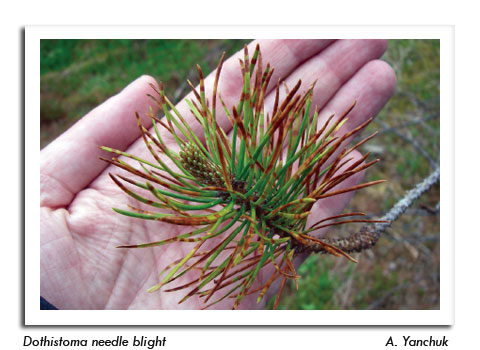
 |
|
|
Nursery & Forest
Volume 58 Number 12 Date 07/25/2013 EUROPEAN ELM FLEA WEEVIL - Moderate infestations of this pest were noted on several elm varieties in Dodge and Jefferson counties. Damaged foliage showed the characteristic blotchy leaf mines resulting from larval feeding between the leaf tissues. Larvae pupate in the leaves and emerge as adult weevils by early July. Adults also cause feeding damage by chewing pinhead-sized, round holes in the foliage. Damage from this insect is primarily cosmetic and maintaining tree health is usually sufficient. If control is required, insecticides are effective against the adults and should be applied at emergence. DOTHISTROMA NEEDLE BLIGHT - This damaging foliar disease was noted on Austrian pines at a nursery in Outagamie County. The causal fungus infects foliage and may kill pines after successive years of severe infection. Symptoms are usually most severe in the lower crown. Pines with dothistroma have needles that progressively turn light green, tan, and brown, while the bases remain green. Copper fungicides can be used to prevent infection. A mid-May application protects needles from previous seasons and a second application 4-6 weeks later protects current-year needles. RHIZOSPHAERA NEEDLECAST - Discoloration of spruce trees in Outagamie County has been attributed to this fungal disease, characterized by browning and early needle loss starting on the lower branches. Needles are infected in spring, turn yellow in July, and then become purplish-brown by late summer and fall. Spruce trees may be treated with a fungicide in spring when the new growth reaches ½-2 inches long, and again 4-6 weeks later to prevent infection. OAK LEAF ROLLER - The damage to red oaks in Price and Washburn counties caused by this leaf rolling insect is expected to subside as the larvae pupate in early August. Treatment to protect landscape oaks is seldom justified. -- Liz Meils, DATCP Nursery Inspector GYPSY MOTH - The 2013 aerial spray season concluded July 23 with the treatment of approximately 38,000 acres in Douglas and Washburn counties with mating disruptant. Nearly 163,000 acres were treated this year at 68 sites in 25 counties, mostly in the western part of the state. Forty-five sites totaling 29,000 acres were treated with Btk, 21 sites totaling 133,000 acres were treated with mating disruptant, and two sites totaling 720 acres were treated with Gypcheck. -- Rick Hummel, DATCP Gypsy Moth Program 


|
|
|